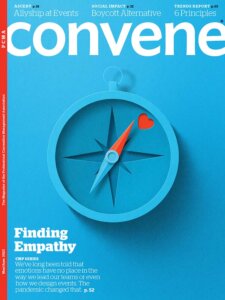
Designing an event with empathy can start by greeting attendees when they check into their hotel rooms with a small gift or handwritten note.

This interview is part of our May/June cover and CMP Series story package. Find the print facsimile edition here.
If you missed the first three parts of our interview with future of work experts and The Empathy Advantage: Leading the Empowered Workforce authors Heather E. McGowan and Chris Shipley, you can catch up here:
- Part 1: ‘It’s About Having Empathy All the Way Around’
- Part 2: ‘Does Leading With Empathy Mean You’re a Pushover?’
- Part 3: What the Back-to-the-Office Challenge Has to Do With In-Person Events
Let’s pick up where we left off, just as they were diving into creating memorable events for a post-COVID audience.
Previously, you talked about the myth of serendipitous connections as a regular occurrence in the workplace — how does that match up to events?
Shipley: I think you have to invert the scope. So often in planning events, it’s the organizer really functioning from a position of how do we get butts in seats? I’ve got to attract an audience. Then I’m going to get terrific speakers to come and I’m going to put them up on my site as the marquee reason why you should come to this event and pay the entry fee. It’s all about the organizer — and that’s not empathetic. If you start with a position of who do I want in the room and what do they need to experience here? — that’s flipping the scope.
If you were designing for any other product, you’d start with the customer and figure out how to build the product for them. I think too often event planners start with, “It’s our annual meeting. How do we get everybody here?” There’s not empathy in that, except for my own need to fill my budget obligation.
I think when you flip that scope to really think about who is it that needs to come together in this room? What needs can we meet for them? How can we make this a great experience for them? — then you open all the creative avenues to create that much more curated, interesting experience that people want to be there.
I would approach it like if I were going to create a new widget, I’d go talk to all the people I thought I was going to sell it to, to see if they really needed it. What event planners do, and I’m guilty, is you put on an event, you are very grateful if the room is filled, and then you survey and say, “How did we do?” By the time the next annual meeting comes around, you might remember some of those things, but it’s usually around the fact that the buffet line wasn’t quite well organized. It becomes very logistics-focused, not content-focused.
One of the things that’s happened for me is a switch from being in the “I’m producing events and bringing in speakers and creating” [mode] — I did a lot of product demonstration events where you curated content and you hoped the right people would show up. I now work on events where I curate the people and I know they will bring the right content. I do a lot of unconference kinds of events and have elements to my programs where we’re saying, “Who needs to be in the room to support one another, to build value among and between individuals there?” Then ask them, trust them to help guide the kinds of conversations that will give them value.
It sounds like you’re saying formats should be more focused on collaboration and interactivity.
Shipley: I think it’s a diversity of formats. Sometimes that unconference format works. I’ve done a small event around the world for the last decade or more and it’s entirely an unconference. People show up and they tell me what they want to talk about and we organize it into a schedule and we have these amazing conversations — people are eager to be part of those events. In other places and for other purposes, that format is probably not nearly as effective but can be integrated with the sage on the stage and the workshops, and the hands-on activities.

Future of work and technology strategists Heather E. McGowan (left) and Chris Shipley previously collaborated on the 2020 book, The Adaptation Advantage: Let Go, Learn Fast, and Thrive in the Future of Work.
I think mixing and matching [is key] — so if I’m sitting in my study on a Zoom, I feel like I will miss something if I don’t get on that plane and be there when I know that there will be these hands-on workshops with other kinds of content. I think it’s looking at how do you create a real menu of experience that allows you to bring in the speakers who are going to really inform the attendees and create opportunities for attendees to interact in ways that help them build value together?
McGowan: I’ve seen a lot more personalization. I get to my [hotel] room [when I speak at an event] and there’s a note saying, “We’re so glad you’re here.” And really thought-out activities — [I spoke at an event] in New York where they gave everybody a passport and had them collect stickers or stamps for meeting somebody you haven’t met before, like go meet someone from another region, another division, because people are not getting together every day, especially when it’s within one company getting together. We’re doing very intentional things to have people have some of those connections and communications and a real emphasis across the board on personalization and reaching out to people before the event and after the event.
Not just a normal “fill out this survey” kind of thing, but, “We noticed you did this.” Some [organizers] are using data to figure out which events you went to and then following up based upon those events. That big push towards personalization, as Chris pointed out, can be ahead of the event in designing it, but it also can be thread right through it from the moment you get to the desk to check in to your hotel, here’s a small gift or here’s a handwritten note. Then you get to your room and there’s something there. It’s just all these touches along the way that makes you feel like, “Oh, I’m glad I came.”
I remember the first time I flew after we opened up from COVID. I fly every airline, but Delta maybe a little bit more than most. There was a handwritten note on my seat, saying, “We noticed this is the first time you’ve flown since COVID. We’re glad to have you back.” I thought, “I’m going to fly more with Delta.” I think it’s a lot more of that and it’s empathetic and it’s human and it’s personalization. Whether it’s travel or events, that is really making a difference.
Michelle Russell is editor in chief of Convene.
